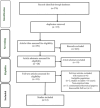Factors Affecting Eating Disorders in Iranian Adolescent Girls: A Scoping Review
- PMID: 40837722
- PMCID: PMC12361642
- DOI: 10.1002/hsr2.71182
Factors Affecting Eating Disorders in Iranian Adolescent Girls: A Scoping Review
Abstract
Background and aims: The World Health Organization declared eating disorders a priority, considering the risks they pose to adolescents' health, especially girls, except for neurological and mental diseases. Knowing the factors related to this problem can be a basis for designing timely and effective interventions. Therefore, this study aimed to identify factors related to eating disorders among Iranian adolescent girls.
Methods: This scoping review was based on the Preferred Reporting Items for Systematic Reviews and Meta-Analyses (PRISMA-SCR). A comprehensive literature search with related keywords was conducted on the Web of Science, PubMed, Scopus, and two Iranian databases, SID and Magiran, without a time limit. The articles were selected based on the entry criteria. After removing duplicates and checking titles, abstracts, and full text, 12 articles were included in the analysis.
Results: Factors affecting eating disorders in Iranian adolescent girls were classified into two main categories: individual (lifestyle and diet, psychological factors, body shape, and menstrual age) and social (family's socioeconomic status, social pressures, and increased awareness).
Conclusions: Eating disorders in adolescent girls are related to several factors. This issue helps to understand the consequences of developing eating disorders and provides the possibility to increase the existing interventions and ultimately improve the treatment for adolescents. Interventions can include education about healthy nutrition, correct information about body image, family support, conducting psychological sessions, and encouraging girls to be physically active.
Keywords: adolescent girls; anorexia nervosa; bulimia nervosa; eating disorder; nutritional disorder.
© 2025 The Author(s). Health Science Reports published by Wiley Periodicals LLC.
Conflict of interest statement
The authors declare no conflicts of interest.
Figures
Similar articles
-
Interventions for preventing eating disorders in children and adolescents.Cochrane Database Syst Rev. 2002;2002(2):CD002891. doi: 10.1002/14651858.CD002891. Cochrane Database Syst Rev. 2002. PMID: 12076457 Free PMC article.
-
Education support services for improving school engagement and academic performance of children and adolescents with a chronic health condition.Cochrane Database Syst Rev. 2023 Feb 8;2(2):CD011538. doi: 10.1002/14651858.CD011538.pub2. Cochrane Database Syst Rev. 2023. PMID: 36752365 Free PMC article.
-
Prescription of Controlled Substances: Benefits and Risks.2025 Jul 6. In: StatPearls [Internet]. Treasure Island (FL): StatPearls Publishing; 2025 Jan–. 2025 Jul 6. In: StatPearls [Internet]. Treasure Island (FL): StatPearls Publishing; 2025 Jan–. PMID: 30726003 Free Books & Documents.
-
Losing weight, gaining confidence? actual weight does not predict body (dis)satisfaction and self-esteem in adolescents with anorexia nervosa.J Eat Disord. 2025 Jul 16;13(1):141. doi: 10.1186/s40337-025-01338-3. J Eat Disord. 2025. PMID: 40671063 Free PMC article.
-
Menstrual hygiene practices and associated factors among Indian adolescent girls: a meta-analysis.Reprod Health. 2022 Jun 23;19(1):148. doi: 10.1186/s12978-022-01453-3. Reprod Health. 2022. PMID: 35739585 Free PMC article.
References
-
- Chae H., “Factors Associated With Body Image Perception of Adolescents,” Acta Psychologica 227, no. 4 (2022): 103620. - PubMed
Publication types
LinkOut - more resources
Full Text Sources



